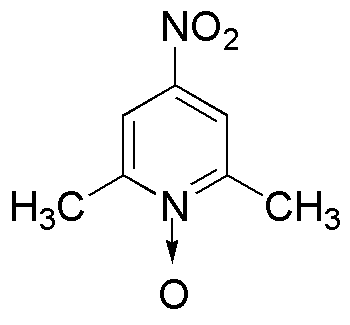2,6-Dichloro-4-nitropyridine N-oxide is widely utilized in research focused on:
- Agricultural Chemistry: This compound serves as an effective herbicide, helping to control unwanted plant growth in various crops, thereby improving yield and reducing competition for resources.
- Pharmaceutical Development: It is used as an intermediate in the synthesis of pharmaceuticals, particularly in developing compounds that target specific biological pathways, enhancing drug efficacy.
- Material Science: The compound finds applications in the development of specialty polymers and coatings, offering improved durability and resistance to environmental degradation.
- Analytical Chemistry: It acts as a reagent in various analytical techniques, aiding in the detection and quantification of other chemical substances, which is crucial for quality control in manufacturing.
- Environmental Monitoring: This chemical is utilized in studies assessing the impact of pollutants, helping researchers understand and mitigate environmental risks associated with agricultural practices.
General Information
Properties
Safety and Regulations
Applications
2,6-Dichloro-4-nitropyridine N-oxide is widely utilized in research focused on:
- Agricultural Chemistry: This compound serves as an effective herbicide, helping to control unwanted plant growth in various crops, thereby improving yield and reducing competition for resources.
- Pharmaceutical Development: It is used as an intermediate in the synthesis of pharmaceuticals, particularly in developing compounds that target specific biological pathways, enhancing drug efficacy.
- Material Science: The compound finds applications in the development of specialty polymers and coatings, offering improved durability and resistance to environmental degradation.
- Analytical Chemistry: It acts as a reagent in various analytical techniques, aiding in the detection and quantification of other chemical substances, which is crucial for quality control in manufacturing.
- Environmental Monitoring: This chemical is utilized in studies assessing the impact of pollutants, helping researchers understand and mitigate environmental risks associated with agricultural practices.
Documents
Safety Data Sheets (SDS)
The SDS provides comprehensive safety information on handling, storage, and disposal of the product.
Product Specification (PS)
The PS provides a comprehensive breakdown of the product’s properties, including chemical composition, physical state, purity, and storage requirements. It also details acceptable quality ranges and the product's intended applications.
Certificates of Analysis (COA)
Search for Certificates of Analysis (COA) by entering the products Lot Number. Lot and Batch Numbers can be found on a product’s label following the words ‘Lot’ or ‘Batch’.
*Catalog Number
*Lot Number
Certificates Of Origin (COO)
This COO confirms the country where the product was manufactured, and also details the materials and components used in it and whether it is derived from natural, synthetic, or other specific sources. This certificate may be required for customs, trade, and regulatory compliance.
*Catalog Number
*Lot Number
Safety Data Sheets (SDS)
The SDS provides comprehensive safety information on handling, storage, and disposal of the product.
DownloadProduct Specification (PS)
The PS provides a comprehensive breakdown of the product’s properties, including chemical composition, physical state, purity, and storage requirements. It also details acceptable quality ranges and the product's intended applications.
DownloadCertificates of Analysis (COA)
Search for Certificates of Analysis (COA) by entering the products Lot Number. Lot and Batch Numbers can be found on a product’s label following the words ‘Lot’ or ‘Batch’.
*Catalog Number
*Lot Number
Certificates Of Origin (COO)
This COO confirms the country where the product was manufactured, and also details the materials and components used in it and whether it is derived from natural, synthetic, or other specific sources. This certificate may be required for customs, trade, and regulatory compliance.


